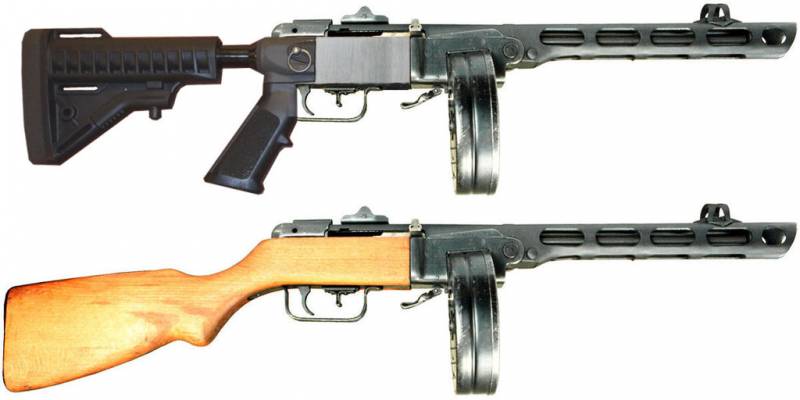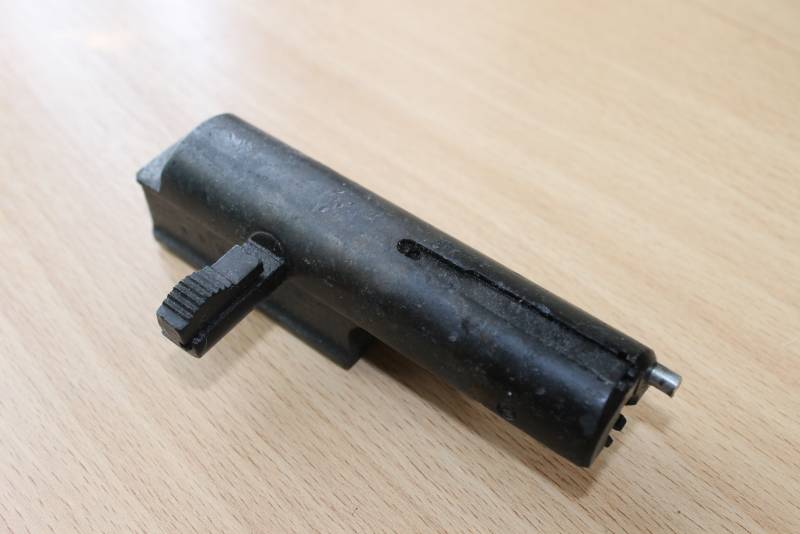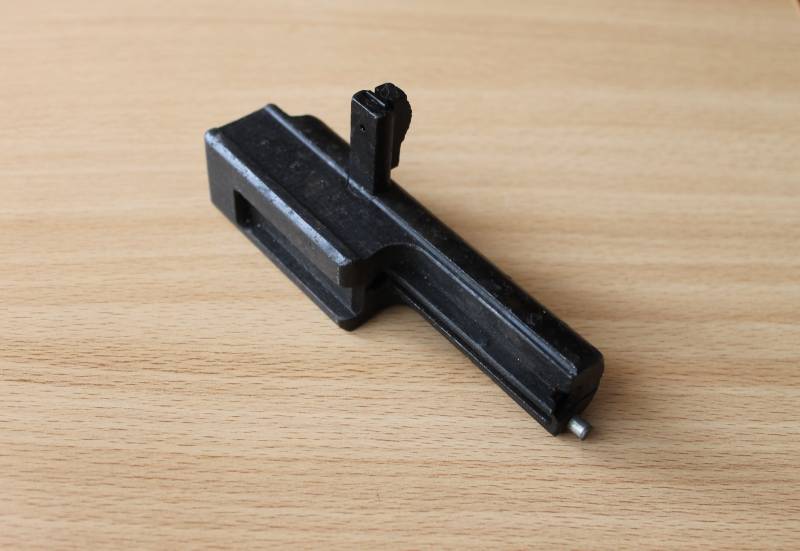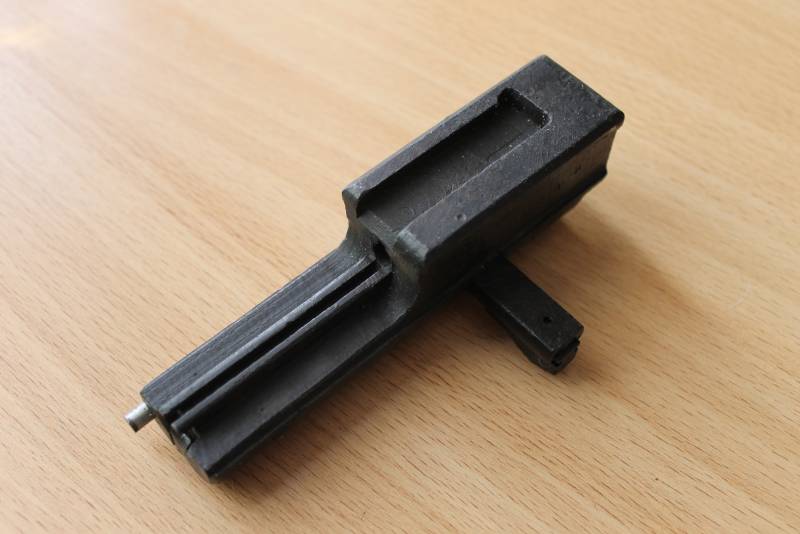Submachine gun: yesterday, today, tomorrow. Part of 7. Spit against Shpagin
That is why, when in 1940, a new submachine gun was chosen from the experience of the Soviet-Finnish war, all the samples presented to it were designed specifically for a pistol cartridge of the 7,62-mm caliber, and nobody even stuttered about the 9-mm caliber.
Submachine gun OKB-15. Left view.
One of the samples presented to it was called OKB-15, and was developed by the B.G. Spit And in the documents, for some reason, it was called the “7,62 caliber infantry machine gun,” although it is clear that this is a real submachine gun. Interestingly, it was proposed to use it not only in infantry, but also as aircraft armament, cavalrymen, parachutists, tankmen and border guards, although it was obvious that for tankers, parachutists and border guards, it was obviously heavy.
Comparing it with PPD and PPSH (future PPSH-41), you need to immediately note the great originality of its design. Usually all the software of the time had automatic, working on the recoil of the free gate, and here Shpitalny also invented the removal of powder gases through the hole made in the wall of the barrel. That is, the bolt in it received two shocks, and besides, some of the powder gases were given to the receiver. It was also unusual that his cartridges were powered from 97 or 100 disk stores with 7,62 × 25 mm cartridges. Although the designer has provided the opportunity to use and shops from PPD on the 71 cartridge.
Externally, the Spitnel submachine gun looked quite traditional: a nut-cut box, a perforated barrel cover, a sector sight and the provided bar for the telescopic sight.
Why was this unusual principle of automation used? Let's put it this way: according to the experience of the Winter War, the designer decided to increase the reliability of the weapon through his ... “self-heating”. No wonder, in the explanation to him it was written that he does not need lubrication and is not afraid of temperature fluctuations. Recall that approximately the same thing was written in the M-16 rifle manual, they say, it cleans the gases themselves! It was noted that due to the greater barrel length than that of other samples, the OKB-15 has a higher initial velocity of the bullet, and therefore it has a large target range, and that is why it was provided with an optical sight.
The weight of the new software in itself was small: 3,890 kg, but with the 100 magazine there were no easy patrons. The firing range was indicated in 1000 m. And it was a very good indicator, although it was unlikely that such a range was necessary for a submachine gun. The rate of fire was 600-800 shots / min.
Tests of all samples were carried out in the second half of November 1940 of the year at the spacecraft NPSVVO in the village Shchurovo, Moscow region.
Compare all the results. The commission that conducted the tests concluded that the SPD was shorter and lighter compared to PCA and OKB-15.
PPD and PPSh have fewer parts and less metal-consuming.
In OKB-15, the initial bullet velocity, muzzle energy and rate of fire are higher.
The accuracy of the battle at distances in 100 and 150 meters PPD and PPSH showed the same results, but OKB-15 had an advantage over them at a distance of 50 and 200 meters.
The survivability of PPD and PPSH (three and two breakdowns) also turned out to be about the same, but at OKB-15 the store was more polluted with gunpowder, and besides, it had eight breakdowns, and one was very serious. PPP PCS understood the fastest, but OKB-15 - the longest.
But the shops at PPD and PP Shpagin were equipped with 137 seconds, but the experimental OKB-15 store, although it contained 97 cartridges, only 108. The main conclusion of the commission was that Spaginsky PP is lighter, more technological, easier to disassemble and assemble, and constructively it turned out to be simpler than all its competitors.
Submachine gun OKB-15. Right view.
According to OKB-15, the remark was also made that a strong heat flux emanates from it through the sleeve opening, which interferes with the observation of the target and aimed shooting. It’s not entirely clear, but didn’t prevent the flow of hot gases from watching the target, beating upwards from the muzzle compensator PPSh upwards, clearly visible on ... any movie “about the war”, where you can see how they shoot PPShs. But, apparently, the flow of gases from the socket opening interfered with the observation more.
At the conclusion of the test site from November 30 1940, the PPSH received a positive recommendation, and instead of the RPD was supposed to come into service with the Red Army. The infantry machine gun Spit test could not stand it, but its designer was recommended to refine it, because its technical solutions deserved attention.

The main competitor of Shpagin and Spital was, in general, also a very good model for his time.
But B.G. Shpitalny, having received such a conclusion, was not satisfied with them, but did not engage in his direct business, but began to “work in the spirit of the day,” that is, scribbling letters to various high authorities with threats against landfill workers, insisting on their criminal prosecution. Apparently the sad experience of Taubin and Kurchevsky went to a number of our designers for the benefit. However, he failed to prove anything, and as a result, the OKB-15 never saw the light.
And here again, it's time to remember about technology. With all its characteristics, the Spit-PC was, if it is possible, more universal than PCA and at the same time ... more difficult. A priority of the Soviet industry of those years was, above all, simplicity and high manufacturability. Appear this submachine gun is not here, but in the United States, with their developed technological base, it was he who would then be adopted. And the Germans, who would have captured him as trophies, would have liked him even more than PCA.
But this modern tuning PPSH-41. And - we note, he may well be in combat formation even now. The only thing you need is to find a niche for its combat use. And there are such niches, and he would be an ideal weapon in them if it were not for ... logistics! It is easier to put one set of universal cartridges than to pick up two or three special purposes !!!
It is not entirely clear why, having refused to Spital, the military did not try to use his 97-cartridge magazine on a Shpagin submachine gun. Of course, authorship is authorship, but when it came to protecting the homeland, it is simply inappropriate to pay attention to such a trifle. However, for some reason a new, more capacious store, by the way, and more quickly reloaded, was not installed on the new software. Well, and then the experience of war made him completely abandon it. By the way, the same experience revealed a number of interesting circumstances, for example, soldiers of many warring armies during the years of WWII liked the enemy’s weapons more than their own!
Shutter to the PPSH-41. The fuse is on the reloading handle and, as it turned out, it was not the best solution.
The Germans, who were neat and pedantic, liked our PPSh, whom they skillfully cared for. English STAN like them for their simplicity and cheapness. But our fighters fell in love with the German MP40. And I fell in love with the lower rate of fire (I didn’t have to think about the consumption of ammunition all the time), and the “stunning” power of his 9-mm bullets. Our 7,62-mm had excessive penetrating power, especially at close distances, but they did not knock the enemy down. “And it came from German — that was it!” Said many of those who used it. On the other hand, one more amusing detail of using PCA was found out: if necessary, holding it by the barrel casing, they could conveniently use in hand-to-hand combat as a cudgel, but the bayonet on short-barreled software turned out to be an odd device.
Shutter to the PPSH-41. Bottom side view.
Shutter to the PPSH-41. Bottom view. In the front of the protruding part of the bolt socket for liner caps and tooth extractor. Hole in the tide - to accommodate the return spring.
And finally, we note that very much in the creation of new types of weapons depended on the opinion, again, of a soldier. That is why the practice included the distribution of questionnaire to the soldiers, which contained questions about what they liked this or that sample of weapons, what they did not like, and ... how would they like to see a kind of “ideal sample”. In some countries, this approach led to interesting results. In particular, it happened in the same Australia. But this will be discussed in our next article.
To be continued ...






Information